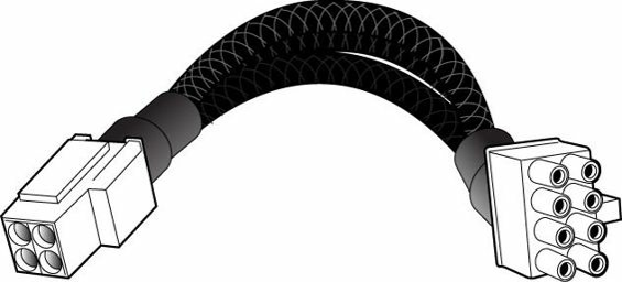Hardware Reference
In-Depth Information
Consult the specific motherboard documentation to see if you can attach a single 4-pin +12V power
connector (offset to one side or the other) when using lower power processors. If you are using a
processor that draws more power than a 4-pin connector can supply, then you should ensure you are
using a power supply with an 8-pin connector to match the motherboard.
Four-Pin to Eight-Pin +12V CPU Power Adapters
If your motherboard requires all 8-pins be connected, and you are using a lower power draw
processor and a power supply that does not have a matching 8-pin +12V connector, you can use an
adapter to convert an existing 4-pin connector to an 8-pin connector. An example of this is shown in
Figure 18.28. Four-pin +12V to 8-pin +12V power adapter.
Adapters are also available that go the other way—that is, they convert an 8-pin CPU power
connector to a 4-pin version. However, these are not always required because one can plug an 8-pin
connector from a power supply into a 4-pin connector on a motherboard by simply offsetting the
connector to one side. The only time the adapter would be needed is if there is a component on the
board that is physically interfering with the portion of the connector that is offset.
Backward and Forward Compatibility
If you have reached this point, I'm sure you have some questions. For example, what happens if you
purchase a new power supply that has a 24-pin main power connector but your motherboard has only
a 20-pin main power socket? Likewise, what if you purchase a new motherboard that has a 24-pin
main power socket but your power supply has only a 20-pin main power connector? The answers to
these questions are surprising to say the least.
There are adapters that can convert a 24-pin connector to a 20-pin type, and the other way around, but
surprisingly these adapters are
not
usually necessary. The truth is that compatibility has been
engineered into the connectors, power supplies, and motherboards from the start.
If you look at the 24-pin main power connector diagram and compare it to the previous 20-pin design,
you'll see that the extra 4 pins are all placed on one end of the connector and all the other pins are
defined the same as they were previously. The design of these connectors is such that it allows an
interesting bit of backward compatibility. The result is that you can plug a 24-pin main connector
directly into a motherboard that has a 20-pin socket (and vice versa) without using an adapter! The
trick is to position the connector such that the 4 extra pins are empty. Depending on the latch design,


